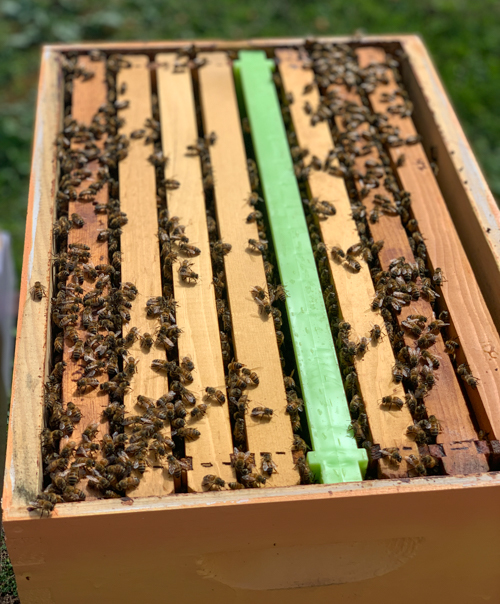
Italian queen, Queen Margherita II
Mid-February is generally the first inspection of the year for me here in San Diego. While we don’t have the same freezing temps as colder climates up north, San Diegans face moisture issues as well as the dreaded Varroa mite, which kills 99% of captive colonies here (I’m exaggerating… but not really).

Inside a Vivaldi box, showing supplemental feed: white fondant, pictured.
It gets cold (and wet) enough to leave them alone from between mid-December to mid-February. You don’t want to disturb their propolis seals during those two coldest months.

Can you find QM2? Her green dot is a dead giveaway.
The first February inspection is an excellent time to confirm what you’ve already seen from occasionally observing the exterior of the hives – hopefully you’ve been seeing active cleansing/foraging flights on warm, sunny days.

You can make your bees use their space more effectively by turning their frames around to make it easier to fill or tend to areas they aren’t maximizing.
Your checklist for your first inspection is to do the following:
- Ensure all colonies have survived winter;
- Check moisture levels: Vivaldi boxes can give moisture a place to exit as well as a great place to feed fondant to your bees;
- Make fresh water available (I dump out the two barrels of water in the apiary and refill them with fresh);
- Ensure there’s adequate room for the queen to lay eggs and for the workers to store pollen + honey;
- Get a visual on your queen: is she alive and laying well?
- Make sure there’s no swarm or supercedure cells present; if so, looks for clues as to why… your workers may know something about your queen that you don’t. If you think she might be failing, let them make a queen and replace her later with a docile queen at your earliest convenience – often, that will be later in the season;
- Ensure there are no pests like small hive beetles, wax moths or ants; take the time now to weed around the hive stands for ant prevention, and if you have your stand legs in oil, clean out the cups and refill with new oil;
- Evaluate food shortage and supplement as needed with fondant or sugar water.

A swarm cell on the bottom of a frame.

Be careful putting your fingers into oil wells! This black widow surprised me in one of mine – she was thriving in there.

I relocated her to the orchard.
Here’s a bit of video I took during inspections. Note that although it’s difficult to get photos/video of everything, it’s worth it later when you can zoom in on a photo, lighten the shadows, and really see what’s going on in advance of your next inspection.
Thanks for looking! Drop me a comment with any questions. xoxo






